

Tank Of The Month FEBRUARY 2008
MINH HUYNH/GoTakuF1
Of LEMON GROVE,CA
My journey into keeping aquariums started when I was a wee boy when my dear father took me to a local pet shop…wait a minute, do you really care? Right, let’s get on with it! Affectionately known as the “Big Tank,” the 130g is an experimental setup to prove, mostly to myself, that it is possible to accomplish more with less. It is a very Spartan set up mainly to focus on the corals of the genus Goniopora and a few others like Catalaphyllia Jardinei and Gorgonians. The “Little Tank” is a 24g NanoCube that uses the same principles as the “Big Tank”. The majority of the corals in these two tanks were given to me as frags by the good folks on SDReefs. In the case of the gonioporas, I obtained most of the specimens as “close to dead” or “dying” from LFS or other hobbyists. The primary goal is to rehabilitate these corals and establish some captive-bred strains for the local hobbyists in San Diego.
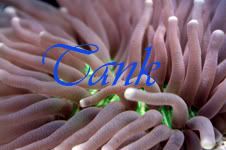
The “Big Tank” is a 130 gallon glass tank with Euro-bracing measuring in at
48”Lx26”Wx24”H. It is rather old, 8 years to be exact, and has the scratches to show.
The “Little Tank” is a standard 24 gallon NanoCube.

Maintenance:
(Fish
an
Some of Minh's Videos
Click the image to enlarge
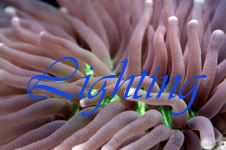
Efficiency was the goal for lighting both the “Big Tank” and “Little Tank.” The latter was an easy selection as the dimensions of the NanoCube limits the viable choice to a 150W metal halide setup. The 150W Giesemann Nova II was chosen for its compact size and sleek design. Unfortunately, the Iwasaki 50k lamp was not available at the time of set up so I went with the next best option, Phoenix 14k. An Ikea lamp post was retrofitted to suspend the Nova II pendant 14” from the tank.
The desired inhabitants of the “Big Tank” would need something both relatively high in PAR (photosynthetic available radiation) and PUR (photosynthetic usable radiation) so a combination of 2x175W Iwasaki 15k and 2x95W Super Actinic VHO was selected. To extract the most performance out of the Iwasaki 15k, a pair of Icecap ballasts coupled with a LumenArc3/LumenMax combo. All the metal halides are on a 6 hour run daily while the VHOs burn 2 hours longer. The top of the 12” tall canopy for the tank is completely open.
Since the lighting setups for both tanks are well vented and run very efficiently, additional cooling is not needed. Also very little equipment is used in-tank and as a result, a chiller and/or fans are not needed to maintain temperature.
There are two 250W Ebo Jager heaters set to 75 degrees on the “Big Tank.” Depending on ambient temperature, the tank temperature swings up to 78-79 degrees at the end of the lighting cycle and drops back to 75 degrees at night. This is the same scheme on the “Little Tank” but is accomplished with a 100W Ebo Jager heater. No temperature controller is employed and these temperature swings are deliberate.


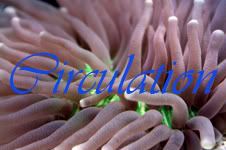
Flow is perhaps the most difficult part of a reef system to design and tune. First, one has to take into account the flow requirement of a system’s intended inhabitants. Second, one has to figure out the most appropriate aquascaping scheme to allow for the best flow pattern. And lastly, the most difficult part comes in finding the right combination of equipment to accomplish these goals. For the “Big Tank,” I decided to go with a very open, low and sparse aquascape design and took care in leaving a 5” perimeter around the tank unobstructed. This design, with the aide of four Maxi-Jet 600 (160gph/7.5W) powerheads on a Tsunami Wavemaker on 45 second alternation can create a gyre reaching around the entire tank. In addition to these four MJ600 powerheads, only a MJ900 is used to feed the behind-tank refugium.
In a similar design in the “Little Tank,” a MJ400 is modified to alternate at a 45 degree angle via a Red Sea Wavemaster Pro. An island aquascape that allows a 3” unobstructed perimeter allows the MJ400’s flow to reach around the entire tank. Additionally a MJ600 is used as a main circulation pump.

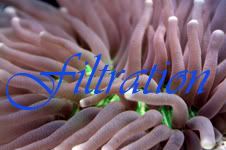
With the intended livestock for the “Big Tank” being rather atypical, some unusual means of filtration had to be implemented. So, kiss that skimmer good buy. Sump, what sump? How about a deep sand bed? Well, there’s no sand at all. Wait a minute; I got to have a fluidized reactor to run phosphate removing media at least? Nope, none! What I do have is a 30 gallon low-flow and gravity returned refugium and a tiny bag of granulated activated carbon. Aside from the 50lbs of live rock in the display and 20lbs of live rock in the refugium, that’s all for filtration for 130 gallons of saltwater. Why did I do this, you ask? Well, this method requires the least amount of effort on my part to maintain as I can be quite lazy. So that means no skimmer to tune or clean. But, more importantly, this filtration method’s primary focus is on micro fauna. Yes, lots and lots of micro fauna. When the tank was initially set up, it was allowed to run for close to 6 months with a few corals and no fish. Without any intervention from me, there was an explosion of life in the tank and especially the refugium. Sponges, aiptasia (great filter feeder), tunicates, worms, dusters, micro crustaceans and countless other “who knows” are teaming in the refugium. There’s also a 1” thick layer of detritus on the bottom of the refugium that I’m convinced is not hurting the tank but could be beneficial. The only intervention on my part is changing out 4 tablespoons of Black Diamond carbon and changing 20 gallons of Reef Crystals mixed water every week. Note: I try to use Scripps natural salt water as much as possible i.e. when I have time to drive 20 miles!
The “Little Tank” is very similar in terms of the simplistic filtration philosophy. About 20 lbs of live rock is used in the tank and a few pieces of rubble in the first stage of the NanoCube faux sump chamber. There is a PAR38 lamp that is fitted behind the tank to light the macro algae-filled second chamber. A 5 gallon water change is all that’s needed weekly from me.

Water Parameters:
Water Parameters for both tanks:
Specific Gravity – 1.025 – 1.027
Temperature – 75-79 degrees
pH - ?
Ammonia - ?
Nitrite - ?
Nitrate - ?
Calcium - ?
Alkalinity - ?
Magnesium - ?
Unfortunately, I can’t tell you the test readings that have a “?” next to them because, well, I don’t know. I don’t test for anything other than salinity and make sure my heaters aren’t broken by glancing at the cheap Coralife thermometer. The best test for water chemistry has always been the observation my corals and fish.
Now, what do I do about water quality? Well, my motto has always been “The solution to pollution is dilution.” So, I just do water changes, very consistently. That’s all, really.
As for supplementation, I have two Litermeter dosing pumps that replenish evaporated water with limewater on both tanks. On the “Big Tank,” I have a 15 gallon bin hidden away that has kalkwasser mixed from RO/DI water (produced by Spectrapure’s MAXCAP) and Mrs. Wages pickling lime. On the “Little Tank,” it is the same scheme but done with a 5 gallon bin. I mix a new batch of kalkwasser every three weeks. Aside from that, I dose 5 ml of “Kent Marine Super Chelated Iron and Manganese” twice a week primarily for my goniopora corals and algal growth.
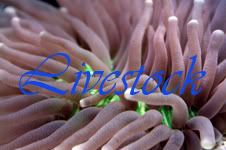 d Inverts):
d Inverts):









Now that all the boring stuff is out of the way, let’s get on with the good stuff. We’ll start with the fish, the complete fish list includes:
- Chelmon rostratus (Copperband Butterfly)
- Chaetodon xanthurus (Pearlscale Butterfly)
- Chaetodon aculeatus (Longnose Butterfly)
- Cirripectes stigmaticus (Stigmata Blenny)
- Atrosalarias fuscus (Golden Blenny)
- Synchiropus splendidus (Male Mandarin)
- Synchiropus splendidus (Female Mandarin)
It’s a rather unimpressive number of fish; however, I like a well-balanced bio-load. I feed them lots and often, most days as much as 4-5 times a day. I alternate between these ingredients:
- Silversides
- Chopped clams
- Clams on a half-shell
- Chopped squid
- Frozen Cyclops-eeze
- Prawn eggs
- Mini-Mysis and brine shrimp with Spirulina mix
- PE Mysis (particularly useful for the butterflies)
- Bloodworms
Those frozen ingredients are soaked in Super Selco and target fed to the butterflies and blennies. In addition to the frozen food, I bring live rock rubble from the refugium full of algae and aiptasia as a treat for the blennies and butterflies a few times a week. I tend to over feed the tank to generate enough micro-algal growth for the grazers, like the blennies and snails. There seems to be no competition for food amongst the two like-sized blennies as they tend to partake in meaty helpings along with the butterflies. The butterflies are voracious eaters. Even being nice and fat, they will flutter around the tank all day long nipping at rocks and a few times, corals, but never enough to do any damage. The mandarin pair pretty much takes care of themselves. The abundance of micro fauna in the refugium and tank keep the both happy, enough to want to get freaky almost every night! Here is a video of said freaky mandarin lovin’: http://www.youtube.com/watch?v=sEf85Soqnxo.
The corals featured in the “Big Tank” are a collection of what has been thought as “hard to keep” specimens in the hobby. For example, the Catalaphyllia Jardinei (Elegance) is a healthy and thriving specimen that normally perishes in most tanks in a few weeks to months. Why not in this tank? My theory for this particular piece’s success has been light acclimation. At one point in the history of his hobby, this coral was as easy to keep in as others in the euphyllia family. However, it could be that their over collection in certain areas of the natural reef has forced divers to collect specimens from greater depths. Now when these specimens reach your tank, they may have been stressed by many different lighting conditions at the holding facilities, wholesalers and LFS. By that point, most specimens are unable to cope with aquarium lighting conditions, whether it is too much or too little. If care is taken to properly acclimate them to a tank’s lighting condition, they can be quite hardy like their cousins torch and frogspawn corals.
Aside from the elegance, the majority of this tank is devoted to corals of the genus goniopora. Like the elegance, goniopra corals’ demise in home aquariums could be a function of acclimation and a lack of proper food. Most brightly neon colored specimens found at LFS are generally bleached and are not in the best of condition. When introduced into the home aquarium, too much or too little lighting could cause them to further stress and expulsion of zooxanthellae results. In addition, too much current could cause the goniopora’s tentacles to stay retracted or partially retracted and therefore not able to capture food. Once proper lighting and flow requirements are met, energy in addition to photosynthesis must be provided in the form of spot feeding. I found this combination of food to be the most acceptable to gonioporas:
- Frozen Cyclops-eeze
- Spectrume flake/pellets crushed to powder
- DT’s Oyster Eggs
- PE Mysis crushed and shaven
- Coral Frenzy
The above ingredients are soaked in Super Selco and cod oil and mashed together to a consistency near that of liquid. This food mix is spot fed to the entire tank two to three times a week. The gonioporas, however, get the bulk of the food. I’ve been able to maintain good health and noticeable growth on the following specimens:
- Goniopora Pearsoni
- Goniopora Pandoraensis (2+ years old)
- Goniopora Palmensis
- Goniopora Stokesi
- Goniopora Lobata
- Goniopora Norfolkensis
- Goniopora Tenuidens
- Alveopora Sp.
Due to the amount of feeding and naturally available micro fauna in the tank, I’ve also had success with the following species:
- Nonphotosynthetic Gorgonians
- Neospongodes
- Tubastreas
- Dendronepthea
- Scleonepthea
The livestock in the “Little Tank” is rather mundane:
- Zoanthids
- Palythoas
- Nepthea
- Capnella
- Rhodactis
- Ricordia
- Clavularia
- Neospongodes
- Cespitularia
- Actinodiscus
- Briareum
























24 Gallon Nano Cube